|
|
Donkey Kong
|
Name:
|
Donkey Kong |
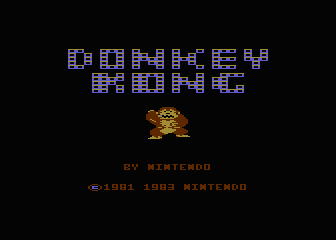 |
| Company: | Atari | |
|
Model #:
|
RX-8031 | |
|
Programmers:
|
Landon Dyer (Programmer), Brad Fuller (Audio), and Mona Lundstrom (Graphics) | |
| Year: | 1983 | |
|
Released?
|
Yes
|
|
|
Notes:
|
Port of the 1981 Nintendo Coin-Op |
Released in 1981, Donkey Kong was a smash hit when it hit
the arcade scene. Not only did Donkey Kong introduce us to
Mario (then called Jumpman), but helped popularized the
platformer genre. Donkey Kong spawned two arcade sequels,
an arcade spin off (Mario Bros.), and numerous home games.
Donkey Kong was as influential to video game history as Pac-Man
helped cement Nintendo as an household name. The home
rights to Donkey Kong were a highly sought after prize which was
claimed not by Atari, but rather by Coleco for their
Colecovision system. So how come Atari was able to produce
Donkey Kong for their system? Due to the wording in the
contract, Coleco only had the rights for 'consoles' not for
computers (this caused problems when Coleco released an upgraded
version for the ADAM). Atari bought the home computer
rights and released Donkey Kong on their Atari 8-Bit line of
computers. They were not however allowed to release it for
their consoles such as the 2600 and 5200. By the time the
Atari 7800 came around Atari had managed to license the console
rights from Nintendo as Coleco was now defunct.
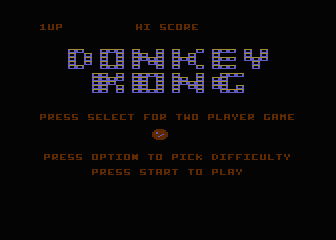
The plot of Donkey Kong is simple. Guide Mario
Jumpman up to the top of each level to rescue Princess
Peach Pauline from the evil clutches of Donkey
Kong Donkey Kong. Each level has its own set of
obstacles to avoid ranging from barrels and FireFoxes to springs
and... cement pies? While Mario's only defense is usually
to jump over or duck under obstacles, he can occasionally grab a
hammer which will allow him to destroy enemies for a limited
amount of time. However when Mario has a hammer he is
unable to climb ladders so use them with caution. It's
also worth noting that Mario is not invincible when using the
hammer and a well timed enemy can still bring him down.
Just like Donkey Kong Jr., Donkey Kong is divided up into four different screens which will repeat until the game ends (following the familiar 1, 4, 1, 2, 4, 1, 3, 4, cycle).
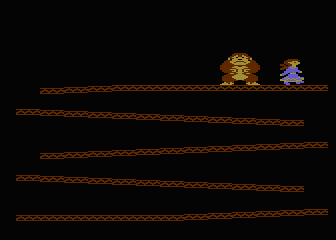
Screen 1: Girders
The girders screen is the standard warm-up screen. Here
Mario has to make his way up a series of five different girders
(down from six in the arcade) in order to reach the top of the
screen where Pauline is being kept. Donkey Kong will
continually roll barrels down the girders which will either roll
of the edges of each level or roll down ladders, eventually
reaching the bottom and being destroyed in a giant flaming
barrel. Occasionally Donkey Kong will also throw a barrel
down the screen which will turn into a FireFox when it hits the
oil can. FireFoxes are intelligent fire creatures which
will follow Mario around and attempt to kill him by touch.
There are two hammers on this screen that can be picked up to
temporarily destroy barrels and FireFoxes, but your best
strategy to to just jump and run. There are also broken
ladders which serve no purpose, although you can attempt to
climb them if you'd like. This screen will also appear
between screens 2 and 3 on higher levels as a 'filler' screen to
pad out the length of the game.
Once Mario makes it to the top, Donkey Kong will grab Pauline and climb up the ladders (well in the arcade version anyway, here he just laughs at you). Let’s quickly move onto…
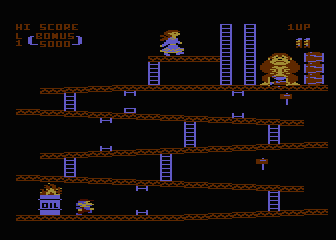
Screen 2: Elevators
One of the tougher screens in the game (why is it always the
second one?). Here Mario must make his way past two
elevators and up a series of small platforms in order to reach
the top. Instead of throwing barrels, Donkey Kong is now
armed with springs which will bounce off the top platform at
crazy speeds. Thankfully the springs can only bounce
forward and off the edge of the top girder, they cannot chase
Mario around the rest of the screen. Of course that
doesn't mean Mario is safe until he gets into spring range, oh
no no no... While navigating the two elevators and the platforms
Mario must also avoid two FireFoxes that are roaming the
area. Unlike the other three screens, there are no hammers
in sight on this screen so Mario cannot destroy the FireFoxes or
springs. Depending on the level, the springs can either
bounce higher and farther, or low and short. The low and
short springs are particularly hard to run under as you make
your way to Pauline's ladder so take care.
Whew, that was intense! Lets continue onward to…
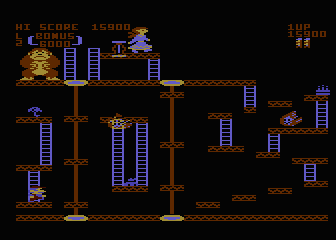
Screen 3: Cement Factory
The Cement Factory is the screen that was left out of most home
versions. In fact most players never get to see it until
they get good at the game so they don’t know it even exists and
are surprised the first time it appears. The Cement
Factory (also called the Pie Factory) is one of the more unique
levels in the game, but is actually fairly easy as long as you
get to the top quickly. Here Mario must make his way along
conveyor belts which are constantly switching direction and
avoid the FireFoxes jumping out of the barrel in the middle of
the screen. Mario must also avoid the pans filled with
sand (which some people call pies) that occasionally move along
the conveyors. In the arcade version the two top ladders
had moving pieces where the player had to wait until they lined
up before they could make it to the top. However in this
port the ladders are always climbable, making Mario's trek just
a little easier.
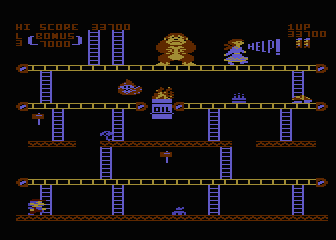
Screen 4: Rivets
The final level of each round, the rivet stage consists of five
platforms that contain eight rivets. Here Mario must walk
or jump over each rivet to remove it, leaving a gap where it was
(careful as you can fall down these holes!). On this level
FireFoxes constantly appear out of nowhere, mercilessly chasing
you. Thankfully the FireFoxes cannot jump the gaps made by
removing the rivets, so use this to your advantage. There
are two hammers on this screen which you can use to defend
yourself in emergencies, but the best strategy is to clear the
level before the FireFoxes become too aggressive. Donkey
Kong and Pauline await you at the top of the screen, but DK will
whisk Pauline to the other side of the screen if you try and
reach her before removing all the rivets (touching Donkey Kong
is deadly).
Once you undo all eight rivets the girders will collapse
and Donkey Kong will fall on his noggin. Mario can now be
with Pauline forever! Unfortunately you know how arcade
games work, Pauline mysteriously gets captured again (and again,
and again, and again) so Mario must begin his quest anew.
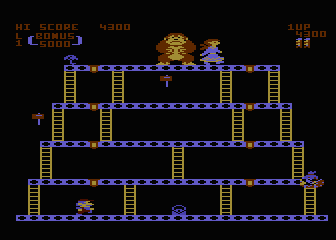
The Atari 8-Bit port of Donkey Kong is widely regarded as
one of the best. Landon Dyer was one of Atari's best
programmers, and his talents really show here. Not only
are all four screen present (not even Nintendo included the
fourth in their NES port), but Mario's movement and jumping feel
natural and sharp. The game moves at a quick pace with
very little if any slowdown or flickering graphics.
Speaking of the graphics, they're are fairly well done
(especially the FireFoxes), but Donkey Kong looks a bit more
like a giant hamster than an ape. Pauline is also a bit
too large and seems to tower over Mario (he barely comes up to
her waist!). The sound and music get the job done, but
Donkey Kong wasn't exactly known for its musical score.
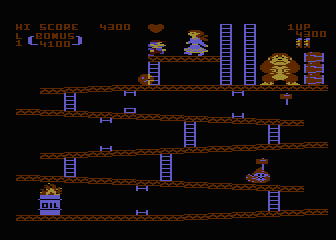
It's a shame that the 8-Bit port of Donkey Kong was never
ported to the 5200 due to the licensing agreement as it's an
amazing port that few people got to see. In recent years
however clever programmers ported the game to the 5200 and it
shines just as brightly there as it does on the Atari
400/800. While it may not look as arcade accurate as the
NES version, it plays better (and has the fourth level) and in
the end it's the gameplay that counts.
| Version | Cart Text | Description |
| 3/21/83 | A.OUT | Intro demo and static screen |
